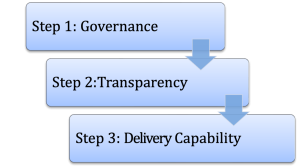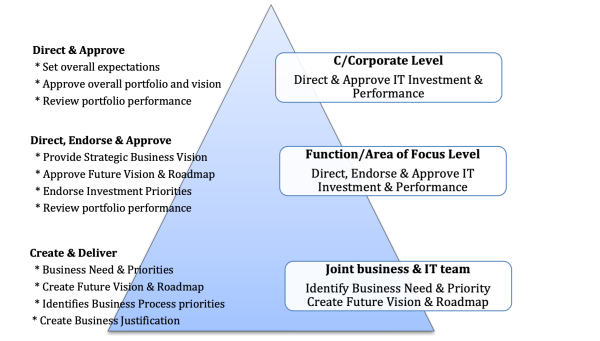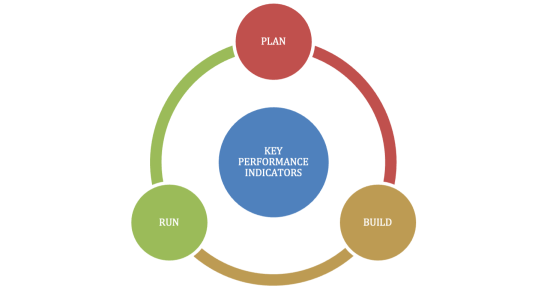IT Governance
Simple But Effective Governance of IT
Should IT be called Information Technology or Innovation Technology? Whatever we call it today’s business needs the right technology driven solutions for it to stay competitive in the global economy. Therefore IT should have just one goal and that is to enable the business to achieve its goals.
Most organizations struggle with IT because the “techies” love to stay in their own cocoon. If the techies moved out into the business to understand the challenges faced by them to meet the needs of the customers and to retain competitive advantage, they will then be able to effectively apply technology to solve business problems. They will also be able to communicate with the business in a language that the business understands.
While this is easier said then done here are a few simple steps an organization of any size can take to ensure alignment between business and IT priorities to grow the business and reduce cost.
The figure below shows the three steps to realize the true value IT can add to the business.

Step 1: Decision making driven by Senior Business Executives
The goal of this step is for business and IT leaders to jointly set and agree on IT priorities. To achieve this goal create a top-down governance structure with two tiers of decision-making process that is supported by detail work done by a joint team of business and IT folks.
The diagram below provides a pictorial view of the governance and decision making structure along with the core responsibilities of each.

The fundamental principal behind this approach is up-front planning to ensure that the organization focuses on key (business critical) initiatives that are aligned to business priorities. Focusing on fewer initiatives and engaging with business stakeholders earlier in engagements, IT projects will be executed far more effectively as well as ensure efficient use of resources.
IT investment will be better balanced because a ‘top-down view’ of investment across the critical areas of focus for the organization will be aligned with business priorities. In addition to up-front planning, effective and appropriate governance is essential to managing investment in IT so that it remains aligned with business vision, direction and priorities. A clear decision making framework is required and therefore a two-tiered approach has been adopted.
At the top tier of this framework the role of the C/Corporate Level Board is to be the IT Investment Management Board. This board will provide the ‘top-down view’ in terms of direction for IT investment. It will focus on setting IT investment targets and priorities at a corporate level.
Supporting the corporate level IT Investment Management Board will be a separate Function/Area of Focus level. These boards will continually validate the future vision for each of the investment areas and ensure that the right steps are being taken to achieve the vision of the future.
The key outcome is a partnership between the business and IT to plan, create, implement and monitor business initiatives that require IT tools & technology.
Step 2: Transparency & Communication
This is the heart and soul of the complete process. The membership of the decision-making committees should be exclusively focused towards the business with the CIO’s governance team conducting and preparing the details for the meetings. The Function/Area of focus level committees should have representatives from all business units.
Each committee should have a charter that defines it accountability and responsibility.
These decision-making bodies should meet quarterly and cover topics like:
Status of executive sponsorship and leadership of each initiative
Performance of the portfolio and the current initiatives
Changes to plans to address changing business priorities and
Specific items on which decisions are needed
The meetings of the two tiers need to be synchronized and scheduled months in advance to accommodate busy calendars of executives. We have found that setting a 12-month calendar based on an “every X day of the month or quarter works the best”.
The decision makers need to be prepped for upcoming decisions so that nothing comes as a surprise to anyone. A lot of background work and preparation is required to make these meetings successful. We recommend that at least a 3 day prep time enables the decision makers to prepare and get others on their teams engaged if needed.
While communicating updates with the decision makers is critical, equally key is keeping the rest of the organization updated on the decisions being made. Therefore a comprehensive communication plan is essential.
This framework positions an organization to deliver real, measurable benefits to the business and all stakeholders. It creates a direct alignment between the business and IT priorities, develops a clear vision for IT that the business understands and is a part of. The relationship between IT and the business will be a lot stronger than ever before. It provides a platform for business growth whilst addressing immediate business needs such as cost control. It creates a WIN-WIN for everyone involved.
Step 3: Establishing a capable delivery organization
All planning and decision making is worth the effort if it is supported by a capable delivery organization. Without a reliable delivery mechanism business benefits will fall short of expectations.
A recommended simple and effective structure to deliver IT solutions includes three stages:
Plan focuses on ensuring IT Strategy and the IT fiscal plan is fully aligned with the business
Build is about an active IT PMO that assures that projects are properly planned and coordinated across all the IT capabilities and the business
Run concentrates its efforts around ensuring IT delivers as promised in all services and ensures coordination with all IT capabilities
This approach to managing the organization streamlines the processes, improves communication and clearly delineates ownership and responsibility in every step to deliver an IT solution as promised.
As with any organization, communication is key. To support communication across all organizational tiers and all stakeholders you need to establish a set of simple high impact Key Performance Indicators (KPIs) that focus on:
– Successes
– Challenges and
– Progress
The following diagram depicts that all project stages need to generate metrics that are visible across all organization layers and stakeholders.

To assist in this use of effective KPI communication organizations should establish a capable PMO. Coordinating and communicating to all business and IT resources is a critical element in the successful delivery of business initiatives. The PMO provides detailed status of current initiatives and articulates its needs both in the short and long-term for success.
The groundwork in preparation for the meetings is a joint effort between the PMO, IT Governance and executive sponsors of the IT initiatives.
Author: Shailendrra Guptaa has served the IT community for over 25 years and has significant experience in strategic planning, establishing program and portfolio management. He has successfully implemented IT Governance structure described at a number of organization including Rolls-Royce, Waukesha Electric Systems. He can be reached at shagupta@gmail.com